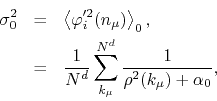Next: The Transversal Propagator Up: Calculations Previous: Calculations
We will now calculate the Gaussian-Perturbative approximation for the
particular observable
![]() , at
some arbitrary point
, at
some arbitrary point ![]() . If we write the observable in terms of
the shifted field we get
. If we write the observable in terms of
the shifted field we get
![\begin{eqnarray*}
{\mathbf O}[\vec{\varphi}']
& = &
\varphi_{\mathfrak{N}}(n_{\mu}')
\\
& = &
\varphi_{\mathfrak{N}}'(n_{\mu}')+v_{0}.
\end{eqnarray*}](img111.png)
In order to get the equation of the critical line we impose, in a self-consistent way, that we in fact have
which is the same as stating that
In the first-order Gaussian-Perturbative approximation this becomes
![\begin{eqnarray*}
\left\langle\varphi_{\mathfrak{N}}'(n_{\mu}')\right\rangle
&...
...{V}[\vec{\varphi}']
\right\rangle_{0}
\right\}
\\
& = &
0.
\end{eqnarray*}](img114.png)
Since we have
![]() ,
because this observable is field-odd and the Gaussian action
,
because this observable is field-odd and the Gaussian action
![]() is field-even, we get for the critical line the
simple equation, known as the tadpole equation,
is field-even, we get for the critical line the
simple equation, known as the tadpole equation,
The expectation value shown here is calculated in Appendix A, given in Equation (A.4), and the result is
The parameter
![]() cancels off from our equation, and thus we
are left with the result
cancels off from our equation, and thus we
are left with the result
in which we now isolated on the left-hand side the term with the external
source. This gives the general relation between ![]() and
and ![]() at
each point
at
each point
![]() of the parameter space of the model. As we
shall see later, from this result we can determine the critical behavior
of the model and derive the equation of the critical line.
of the parameter space of the model. As we
shall see later, from this result we can determine the critical behavior
of the model and derive the equation of the critical line.
The quantity ![]() is the width or variance of the local
distribution of values of the field components
is the width or variance of the local
distribution of values of the field components
![]() ,
with
,
with
![]() , in the measure of
, in the measure of
![]() ,
,

as one can see in Appendix B, Equation (B.6),
and has the following interesting properties, so long as ![]() . First,
it is independent of the position
. First,
it is independent of the position ![]() , as translation invariance
would require. Second, for
, as translation invariance
would require. Second, for ![]() it has a finite and non-zero
it has a finite and non-zero
![]() limit, so long as
limit, so long as
![]() with a finite
value of
with a finite
value of ![]() in the limit. Finally, the value of
in the limit. Finally, the value of ![]() in the
limit does not depend on the value of
in the
limit does not depend on the value of ![]() in that same limit.
Analogously, the quantity
in that same limit.
Analogously, the quantity
![]() is associated to the remaining
field component
is associated to the remaining
field component
![]() and to the mass parameter
and to the mass parameter
![]() , and has these same properties. In fact,
, and has these same properties. In fact, ![]() and
and
![]() have exactly the same value in the
have exactly the same value in the ![]() limit.
limit.